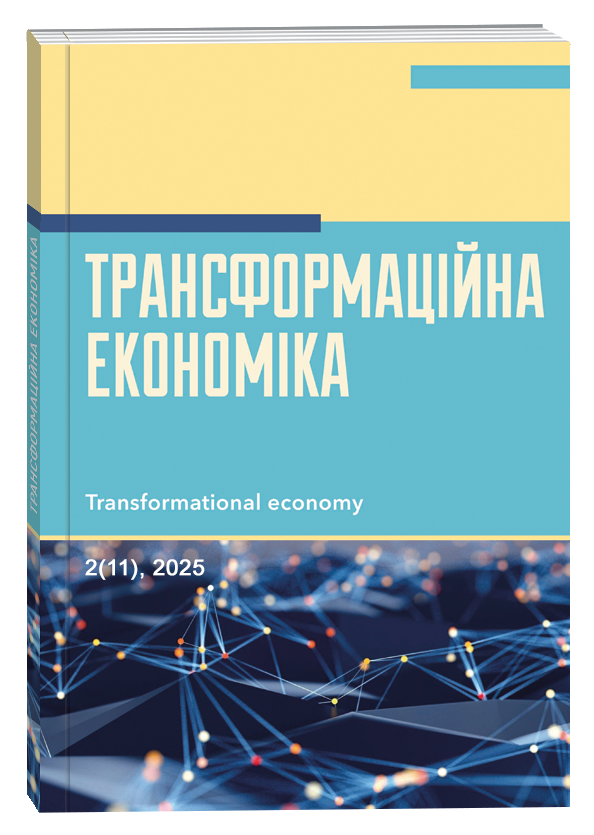THE PARADIGM OF FINANCIAL RESTRUCTURING IN CRISIS MANAGEMENT OF BUSINESS ENTITIES
Abstract
The purpose of the article is to study and substantiate conceptual approaches to the formation of a modern paradigm of financial restructuring in the anti-crisis management of business entities, taking into account the challenges of the competitive environment, post-industrial development and conditions of post-war economic recovery in Ukraine. The article examines the topical aspects of forming the paradigm of financial restructuring in the system of anti-crisis management of business entities under martial law and future post-war recovery. The article highlights the complex impact of the armed aggression of the Russian Federation on Ukrainian enterprises that have found themselves in conditions of financial instability, loss of tangible assets, reduced domestic demand and difficult access to resources. The authors note that in such circumstances, financial restructuring should acquire a new meaning - not only as an operational stabilisation tool, but also as a long-term strategy for transforming the management system aimed at increasing the efficiency of using the internal potential of an enterprise. The author emphasises the importance of integrating restructuring measures into the overall concept of crisis management, taking into account limited resources, growing debt burden, and the need to maintain investment attractiveness and confidence in the economy. It is substantiated that the post-war period will require a systematic approach to managerial changes, in particular through the reorganisation of financial structures, introduction of modern management practices and strengthening the role of intellectual capital. The methodological basis of the study is the enterprise life cycle models of L. Greiner and I. Adizes, which allow identifying key points of organisational transformation and determining the optimal stages for implementing restructuring. It is concluded that the anti-crisis potential of an enterprise should be formed as an integrated system of financial, managerial and personnel decisions, which allows not only to respond to crisis challenges, but also to actively transform in accordance with the dynamic market conditions. Financial restructuring, in this sense, is not a temporary measure, but one of the key elements of sustainable economic development in the face of uncertainty and constant change.
References
Гайдаржийська О. М., Лесик А. В. Антикризове управління як інструмент фінансової реструктуризації підприємства. Економіка. Фінанси. Право. 2017. № 4(1). С. 30–32.
Гринько Т. Стратегія як інструмент антикризового управління на підприємстві. Економіст. 2013. № 8. С. 51–53.
Давиденко Н. М. Антикризове фінансове управління на підприємстві. Науковий вісник НУБіП України. Серія: Економіка, аграрний менеджмент, бізнес. 2016. Т.1. Вип. 211. URL: https://journals.nubip.edu.ua/index.php/Economica/article/.../5938 (дата звернення: 20.05.2025).
Давиденко Н. М. Оцінювання ефективності антикризової діагностики. Серія: Економічна. 2018. Вип. 35. С. 108–111.
Злепко Н., Антипенко Н. Реструктуризація та розвиток: державна політика для стабілізації української економіки під час воєнного стану. Актуальні питання у сучасній науці. 2023. № 12 (18). С. 76–88.
Калюжна Ю. В. Ризики в системі антикризового управління підприємствами машинобудування: автореф. дис. … канд. екон. наук: спец. 08.00.04 – Економіка та управління підприємствами (за видами економічної діяльності). Запорізький національний університет, 2016. 23 с.
Куницька-Іляш М. Державна політика забезпечення розвитку та безпеки пріоритетних галузей національної економіки України: аналіз стратегій і програм. Innovation and Sustainability. 2022. № 3. C. 72–78.
Кушнір Н.Б., Войтович Д.С. Особливості антикризового управління та економічної діагностики підприємства в сучасних умовах. Ефективна економіка. 2016. № 5. URL: http://www.economy.nayka.com.ua/?op=1&z=4954 (дата звернення: 16.05.2025).
Прус Л. Р. Управління потенціалом підприємства: навч. пос. Хмельницький : Метод.-ред. центр ПВНЗ «УЕП», 2010. 364 с.
Adizes I. Managing Corporate Lifecycles: An Updated and Expanded Look at the Corporate Lifecycles. [First printing]. New-Jersey: Prentice Hall Press. 1999. 319 p.
Buchheit C., Lerrick A. A modern template for the restructuring of poor country debts. Capital Markets Law Journal. 2023. № 18.2. P. 194–201.
Bundy J. Pfarrer M. D., Short C. E., Coombs W. T. Crises and Crisis Management: Integration, Interpretation, and Research Development. Journal of Management. 2017. Vol. 43. № 6. P. 1661–1692. DOI: https://doi.org/10.1177/0149206316680030 (дата звернення: 15.05.2025).
Garrido M., Rasekh A., Rosha A. Restructuring and Insolvency in Europe: Policy Options in the Implementation of the EU Directive. International Monetary Fund, 2021. 53 р.
Drucker P. Management: tasks, responsibilities, practices / Peter Drucker. Revised Edition. E-Book, provided by the Peter F. Drucker Literary Trust. – 1973, 1974 and 2008. Available at: http://youth-portal.com/wp-content/uploads/2014/10/Peter-F-Drucker-Management-Rev-Ed.pdf (дата звернення: 19.05.2025).
Greiner L. Evolution and Revolution as Organizations Grow. Harvard Business Review. 1972. Vol. 50. № 4. P. 37–46.
Gaidarzhyska O. M., Lesyk A. V. (2017). Antykryzove upravlinnia yak instrument finansovoi restrukturyzatsii pidpryiemstva [Crisis management as a tool for financial restructuring of an enterprise]. Ekonomika. Finansy. Pravo – Economics. Finance. Law. Іssue 4(1), рр. 30–32.
Grinko T. (2013). Stratehiia yak instrument antykryzovoho upravlinnia na pidpryiemstvi [Strategy as a tool for crisis management at an enterprise]. Ekonomist – Economist. Іssue 8, рр. 51–53.
Davydenko N.M. (2016). Antykryzove finansove upravlinnia na pidpryiemstvi [Anti-crisis financial management at the enterprise]. Naukovyi visnyk NUBiP Ukrainy. Seriia: Ekonomika, ahrarnyi menedzhment, biznes – Scientific Bulletin of NUBiP of Ukraine. Series: Economics, agrarian management, business. Т.1. Іssue 211. Available at: https://journals.nubip.edu.ua/index.php/Economica/article/.../5938 (accessed May 20, 2025).
Davydenko N. M. (2018). Otsiniuvannia efektyvnosti antykryzovoi diahnostyky [Evaluating the effectiveness of crisis diagnostics]. Seriia: Ekonomichna – Series: Economic, is. 35, рр. 108–111.
Zlepko N., Antipenko N. (2023). Restrukturyzatsiia ta rozvytok: derzhavna polityka dlia stabilizatsii ukrainskoi ekonomiky pid chas voiennoho stanu [Restructuring and development: state policy to stabilise the Ukrainian economy during martial law]. Aktualni pytannia u suchasnii nautsi – Topical issues in modern science. Іssue 12 (18), рр. 76–88.
Kalyuzhna, Yu. V. (2016). Ryzyky v systemi antykryzovoho upravlinnia pidpryiemstvamy mashynobuduvannia [Risks in the system of crisis management of enterprises of mechanical engineering]. Ph.D. Thesis, Economics and Management of Enterprises (by type of economic activity). Zaporizhzhya National University, 23 p.
Kunitskaya-Ilyash M. (2022). Derzhavna polityka zabezpechennia rozvytku ta bezpeky priorytetnykh haluzei natsionalnoi ekonomiky Ukrainy: analiz stratehii i prohram [State Policy of Ensuring Development and Security of Priority Sectors of the National Economy of Ukraine: Analysis of Strategies and Programmes]. Innovation and Sustainability. Іssue 3, рр. 72–78.
Kushnir N. B., Voitovych D. S. (2016). Osoblyvosti antykryzovoho upravlinnia ta ekonomichnoi diahnostyky pidpryiemstva v suchasnykh umovakh [Peculiarities of crisis management and economic diagnostics of an enterprise in modern conditions]. Efektyvna ekonomika – Efficient economy. № 5. Available at: http://www.economy.nayka.com.ua/?op=1&z=4954 (accessed May 16, 2025)
Prus L. R. (2010). Upravlinnia potentsialom pidpryiemstva: navch. pos. Enterprise potential management: [a study guide]. Khmelnytskyi: Methodological and editorial centre of the UEP, 364 р.
Adizes I. (1999). Managing Corporate Lifecycles: An Updated and Expanded Look at the Corporate Lifecycles. [First printing]. New-Jersey: Prentice Hall Press, 319 p.
Buchheit C., Lerrick A. (2023) A modern template for the restructuring of poor country debts. Capital Markets Law Journal. Іssue 18.2, pp. 194–201.
Bundy J. Pfarrer M. D., Short C. E., Coombs W. T. (2017). Crises and Crisis Management: Integration, Interpretation, and Research Development. Journal of Management. Vol. 43. Іssue 6, pp. 1661–1692. DOI: https://doi.org/10.1177/0149206316680030 (accessed May 15, 2025).
Garrido M., Rasekh A., Rosha A. (2021). Restructuring and Insolvency in Europe: Policy Options in the Implementation of the EU Directive. International Monetary Fund, 53 р.
Drucker P. (2008). Management: tasks, responsibilities, practices. Revised Edition. E-Book, provided by the Peter F. Drucker Literary Trust. Available at: http://youth-portal.com/wp-content/uploads/2014/10/Peter-F-Drucker-Management-Rev-Ed.pdf (accessed May 19, 2025).
Greiner L.(1972). Evolution and Revolution as Organizations Grow. Harvard Business Review. Vol. 50. Іssue 4, pp. 37–46.


